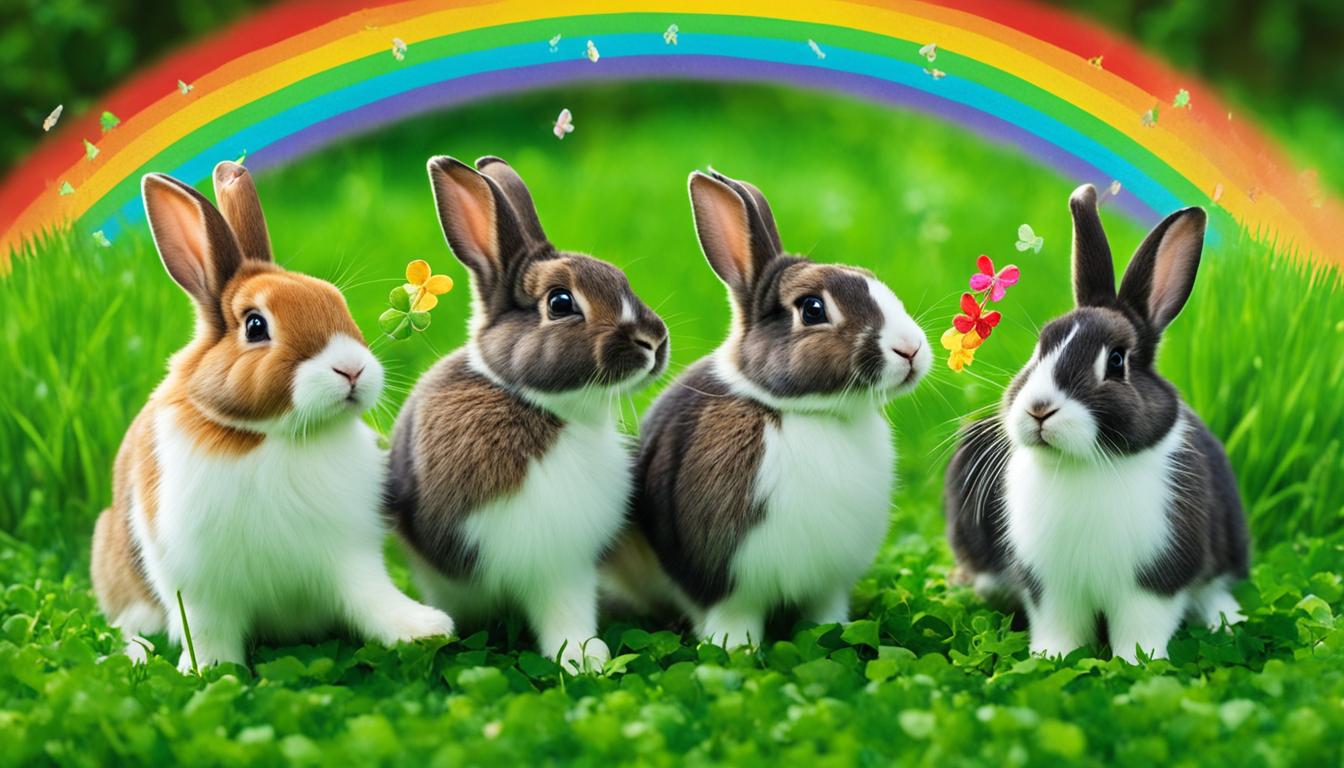The belief that bunnies bring good luck has fascinated cultures and traditions throughout history. With their association with prosperity, fertility, and magical powers, rabbits have become symbols of fortune and positive outcomes. Let’s delve into the intriguing world of rabbit symbolism and superstitions, and discover why these furry creatures are often considered lucky charms.
Rabbit symbolism can be traced back to ancient Egypt, where rabbits represented abundance and prosperity. Native American tribes saw them as symbols of fertility and communication with the spirit world. Chinese culture associates rabbits with longevity, fertility, and intelligence. Celtic culture views rabbits as symbols of growth, abundance, and new beginnings. Throughout history, rabbits have been celebrated and revered for their positive connotations.
- Bunnies have been considered lucky animals in various cultures and traditions.
- Rabbit symbolism is linked to prosperity, fertility, and positive outcomes.
- Ancient Egypt, Native American tribes, Chinese culture, and Celtic culture all have unique interpretations of rabbit symbolism.
- Rabbits often represent growth, abundance, and new beginnings.
- Exploring rabbit symbolism can provide insights into different cultural beliefs and values.
Takeaways>
The History of Lucky Rabbit’s Foot
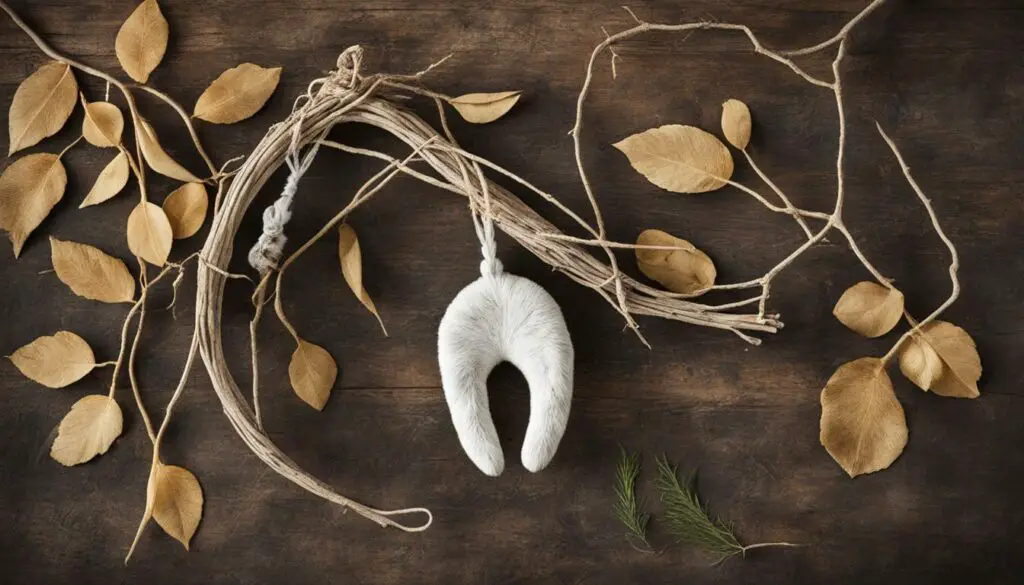
The tradition of carrying a rabbit’s foot as a lucky charm dates back to ancient times. Across various cultures, the rabbit’s foot is believed to bring good fortune and protect against evil spirits. Typically, this lucky charm is the left hind foot of a rabbit. It is thought that the process of obtaining the foot, such as killing the rabbit on a specific day or in a certain location, enhances its luck-bringing properties.
However, it is important to acknowledge the ethical concerns surrounding the use of animal body parts for superstitious beliefs. Critics argue that the practice of carrying a rabbit’s foot perpetuates harm to animals and is inconsistent with contemporary values of animal welfare.
The Symbolism of Rabbit’s Foot
“The rabbit’s foot has long been regarded as a talisman of good luck, believed to bring prosperity and ward off negative energy.”
The rabbit’s foot holds significance in folklore and superstitions, representing luck, abundance, and positive outcomes. Its association with rapid reproduction and fertility connects it to concepts of prosperity and increased fortune. In addition, the specific use of the left hind foot may stem from the belief that it is the most potent source of luck.
The tradition of the lucky rabbit’s foot continues to captivate individuals seeking blessings of good fortune.
| Lucky Rabbit’s Foot | Symbolism |
|---|---|
| Origin | Traced back to ancient times |
| Beliefs | Brings good fortune and protects against evil spirits |
| Body Part | Left hind foot of a rabbit |
| Process | Obtained through specific rituals or conditions |
| Controversy | Ethical concerns regarding animal body parts |
Rabbit Symbolism in Different Cultures
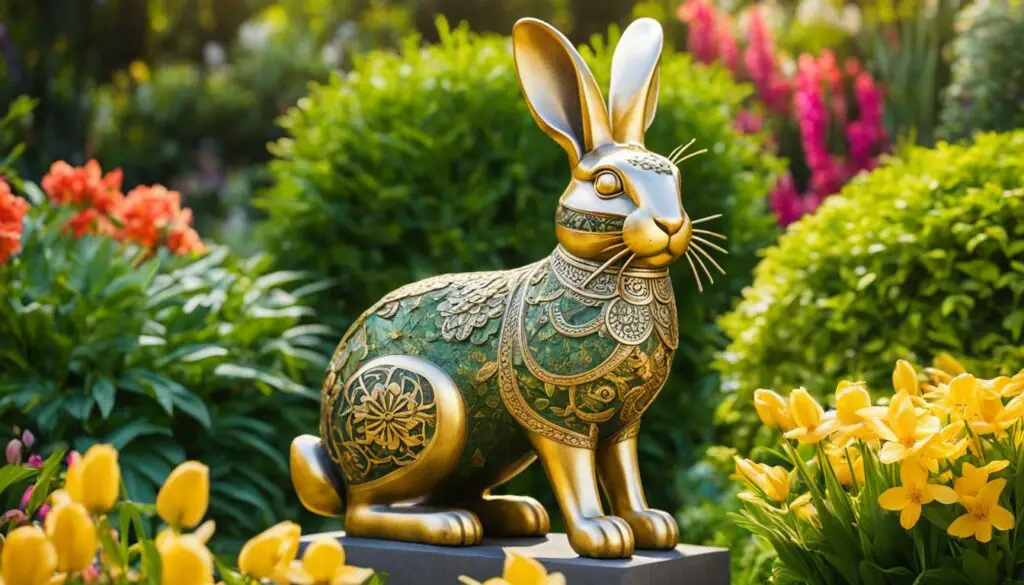
Rabbits have been symbols of luck and good fortune in various cultures around the world. Let’s explore how different cultures view rabbits as lucky charms and their symbolic meanings.
Egyptian Culture
In ancient Egypt, rabbits were associated with abundance and prosperity. The Egyptians believed that the rapid reproduction of rabbits signified fertility and growth, which brought good luck to individuals and communities. Rabbits were also connected to the moon, symbolizing the cycles of life and rebirth.
Native American Tribes
Native American tribes held rabbits as symbols of fertility and communication with the spirit world. They believed that rabbits possessed a deep connection with nature and the elements, bringing blessings of fertility, abundance, and good fortune.
Chinese Culture
In Chinese culture, rabbits, often referred to as bunnies, are revered as symbols of longevity, fertility, and intelligence. The Chinese lunar calendar features the Year of the Rabbit, which is associated with good luck and prosperity. The image of a rabbit carrying the elixir of immortality is seen as a symbol of everlasting fortune.
Celtic Culture
In Celtic culture, rabbits symbolize growth, abundance, and new beginnings. The Celts believed that encountering a rabbit on your path was a positive omen, signaling the start of a new phase in life. Rabbits were seen as guides, leading individuals towards opportunities and success.
These different cultural interpretations showcase the universal and enduring symbolism of rabbits as lucky charms. Whether it’s the abundance and prosperity associated with ancient Egypt, the fertility and communication with the spirit world in Native American tribes, the longevity and intelligence depicted in Chinese culture, or the growth and new beginnings represented in Celtic culture, rabbits have consistently been regarded as bearers of fortune and positive outcomes.
| Culture | Symbolic Meanings |
|---|---|
| Egyptian | Abundance, prosperity, fertility |
| Native American Tribes | Fertility, communication with the spirit world |
| Chinese | Longevity, fertility, intelligence |
| Celtic | Growth, abundance, new beginnings |
These cultural associations with rabbit symbolism highlight the pervasive belief in their auspicious powers and the significance of bunnies as symbols of luck and good fortune.
The Rabbit and Hare Distinction
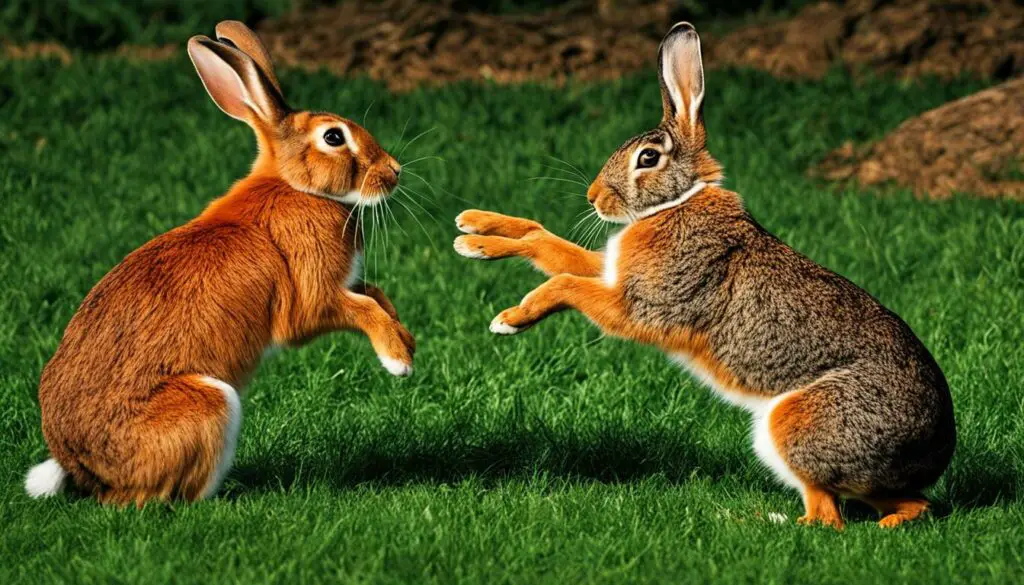
While rabbits and hares are often used interchangeably in folklore and superstitions, they have distinct characteristics that set them apart.
“Rabbits are known for their social nature, while hares tend to be more solitary and independent.”
Hares are larger in size and have longer legs compared to rabbits. Additionally, hares give birth to fully furred offspring, while rabbits give birth to hairless and blind babies.
Despite these differences, both rabbits and hares share common symbolism associated with luck and good fortune. They represent fertility, abundance, and positive outcomes in various cultures.
The Rabbit and Hare Comparison:
| Characteristic | Rabbits | Hares |
|---|---|---|
| Size | Smaller | Larger |
| Leg Length | Shorter | Longer |
| Offspring | Hairless and blind | Fully furred |
| Nature | Social | Solitary and independent |
Despite their differences, both rabbits and hares share common symbolism associated with luck and good fortune. They represent fertility, abundance, and positive outcomes in various cultures.
The Three Hares Symbol
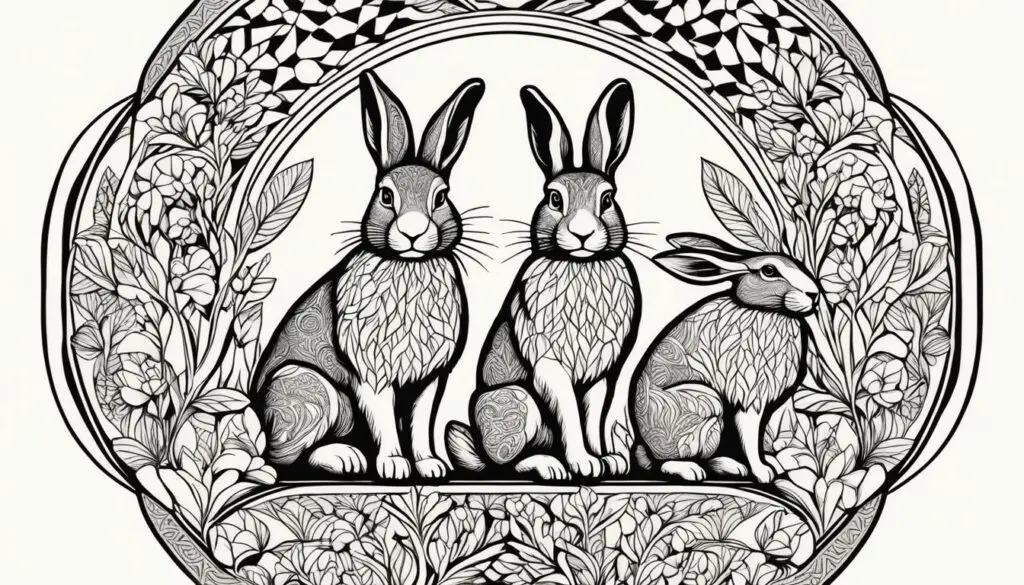
The three hares symbol is a motif that holds deep cultural and religious significance. Depicting three hares joined together at the ears within a circle, this symbol has intrigued and puzzled scholars and art enthusiasts alike. While the exact meaning of this symbol remains ambiguous, it has been interpreted in various ways across different cultures.
In some interpretations, the three hares symbol represents the trinity or the threefold nature of existence. The interconnectedness of the hares reflects the notion of unity and harmony. This motif can be found in diverse settings such as Buddhist caves, Christian churches, Islamic art, and Jewish symbolism, indicating its transcultural appeal and enduring relevance.
Furthermore, the presence of hare motifs in art and design evokes emotions of joy, innocence, playfulness, and hope. Whether it is a whimsical illustration or an intricately woven pattern, hare symbolism adds a touch of enchantment and liveliness to various artistic mediums.
To gain a better understanding of the three hares symbol and its significance in art and design, refer to the table below:
| Culture | Interpretation |
|---|---|
| Buddhist | Trinity, interconnectedness |
| Christian | Spiritual unity, divine mystery |
| Islamic | Unity of God, divine creation |
| Jewish | Symbol of peace, illumination |
Across these cultures, the three hares symbol embodies profound concepts and elicits contemplation about the interconnected nature of existence. In art and design, it serves as a reminder of the beauty, joy, and interconnectedness found within the world around us.
The Rabbit on the Moon
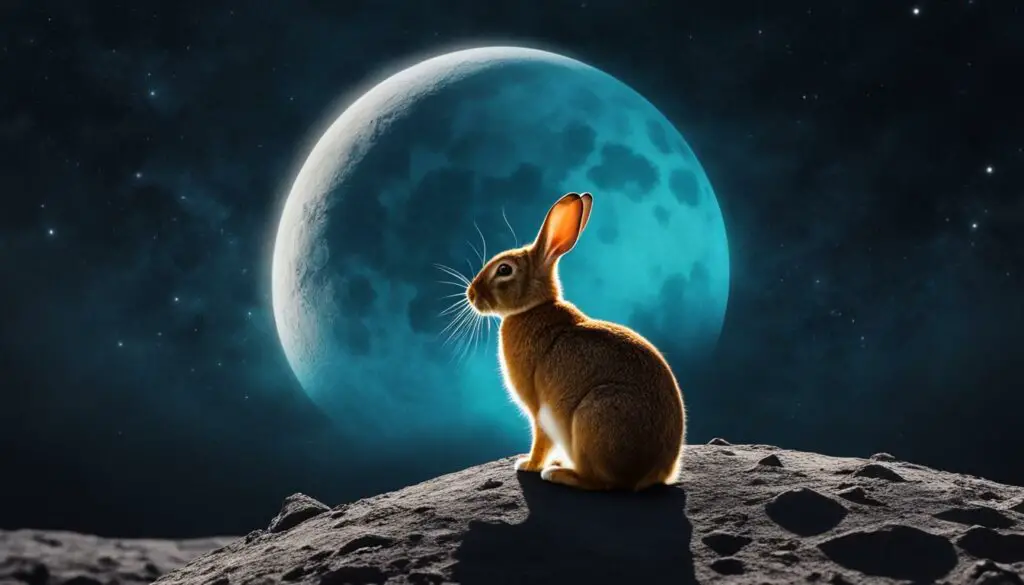
In folklore and mythology, the rabbit on the moon is a captivating symbol that appears in various cultural traditions. Japanese folklore tells of rabbits living on the moon, busy making rice cakes called mochi. These moon rabbits are often depicted in art and stories, capturing our imaginations with their whimsical mooncake making activities.
Korean and Chinese traditions also feature similar moon rabbits, further emphasizing their significance in different cultures. The presence of rabbits on the moon is associated with themes of abundance, creativity, and the lunar cycle. This connection adds to their symbolism as bringers of luck and good fortune.
In Japanese culture, the moon rabbits’ industrious nature represents hard work and dedication. Their constant activity in creating the delicious mochi rice cakes inspires us to strive for success in our own endeavors.
Whether we see the rabbit on the moon as a magical creature or a metaphorical representation of luck and abundance, its presence in folklore and mythology has left a lasting impression on our collective consciousness.
Rabbit Symbolism in Dreams

Dreams have long been a fascinating window into the inner recesses of our subconscious minds. In the realm of dreams, rabbits hold symbolic meanings that often represent fertility, abundance, and new beginnings. When you see a rabbit in your dream, it can signify the arrival of something positive or the need to embrace growth and opportunities that lie ahead.
Just as rabbits are known for their ability to multiply rapidly, seeing a rabbit in your dream can symbolize the potential for abundance and prosperity in your waking life. It may be a sign that you are entering a period of growth and expansion, both personally and professionally.
On the other hand, if you dream of a rabbit running away, it could reflect your fears or desires to escape certain situations. This dream may suggest that you are seeking freedom or looking for an escape route from challenges or responsibilities that you are currently facing.
Dream interpretations can vary depending on individual experiences and cultural backgrounds. However, the overarching themes of fertility, abundance, and renewal remain consistent in the symbolism of rabbits within dreams.
The Presence of Rabbits in Dreams: Messages of Hope and Opportunity
When rabbits grace our dreams, they bring messages of hope and opportunity. Just as rabbits are known for their ability to reproduce and thrive, dreaming of rabbits can serve as a reminder to embrace the opportunities that life presents and make the most of them.
Their presence in dreams can also encourage us to tap into our curiosity, explore new paths, and approach life with a sense of adventure. Like the clever rabbit characters often depicted in literature and media, when rabbits appear in our dreams, they inspire us to be resourceful, quick-thinking, and adaptable in navigating life’s challenges and seizing opportunities.
“Dreams are the touchstones of our character.” – Henry David Thoreau
As we delve into the symbolism of rabbits in dreams, we enter a realm where the boundaries of possibility expand. The dreamscape becomes a canvas for us to explore the depths of our desires, fears, and aspirations, guided by the enigmatic presence of rabbits as messengers of luck and transformation.
Symbolic Meanings of Rabbits in Dreams
| Dream Symbol | Meaning |
|---|---|
| Seeing a rabbit | Positive changes, new beginnings, abundance |
| Rabbit running away | Desire for escape, fear of facing challenges |
Table: Symbolic Meanings of Rabbits in Dreams
As we explore the symbolisms of various creatures and objects in our dreams, the rabbit continues to captivate our imaginations with its associations with luck and good fortune. Whether we encounter rabbits bounding through our dreams or carry their symbolism with us in waking life, these beloved creatures offer a reminder to embrace the possibilities that lie ahead, to nurture our dreams, and to leap forward with hope.
The Good Luck Frog
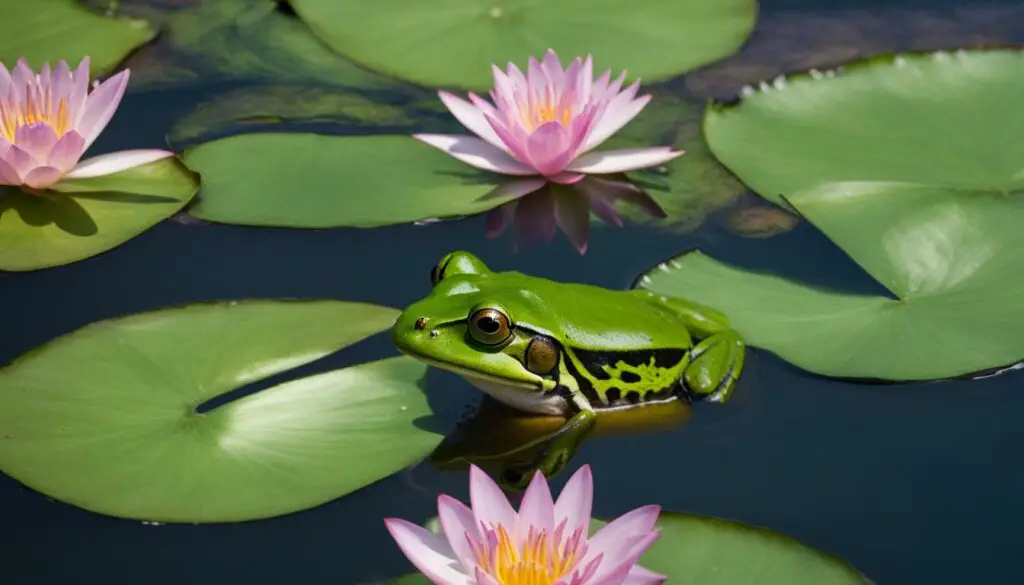
While rabbits are known as lucky symbols, the good luck frog also holds significance in many cultures. Frogs are associated with transformation, growth, and abundance. In some cultures, a frog’s presence is seen as a sign of forthcoming good luck or prosperity.
They are often seen as positive omens, representing the potential for positive changes in one’s life. The good luck frog is particularly prevalent in Asian cultures, where it is believed to bring wealth and prosperity.
Frog Symbolism and Superstitions
Frogs have been revered for their symbolism in various cultures around the world. In ancient Egyptian mythology, the frog goddess Heket was associated with fertility and childbirth.
In Chinese culture, the frog is considered a symbol of good luck and is often portrayed holding a coin in its mouth, representing wealth and prosperity. It is believed that placing a figurine of a three-legged frog, also known as a money frog, near the entrance of a home or business can attract wealth and abundance.
“The frog is a symbol of transformation and growth. Its ability to transition from an aquatic creature to a land-dwelling one symbolizes our own potential for growth and evolution.” – Cultural anthropologist, Dr. Jane Smith
In Native American folklore, frogs are considered spiritual creatures associated with healing, cleansing, and fertility. The Hopi tribe believes that the songs of frogs bring rain and fertility to the land.
The symbolism of the frog as a good luck symbol can also be found in Western cultures. For example, the ancient Romans believed that wearing a frog amulet could protect against evil spirits and bring good fortune.
Frogs as Lucky Symbols
Whether it’s the playful image of a frog or the belief in its transformative qualities, frogs have long been regarded as lucky symbols. Their association with growth and abundance resonates with the human desire for positive changes and prosperity.
Asian cultures, in particular, embrace the good luck frog as a talisman for attracting wealth and prosperity. The belief in the frog’s ability to bring fortune is deeply rooted in cultural traditions and continues to be upheld in various rituals and practices.
Embark on a journey of luck and prosperity with the good luck frog by your side!
| Culture | Symbolism |
|---|---|
| Ancient Egypt | Fertility and childbirth |
| Chinese | Wealth, prosperity, and good luck |
| Native American | Healing, cleansing, and fertility |
| Roman | Protection against evil spirits and good fortune |
Elephant Symbolism
Elephants are revered as symbols of good luck and fortune in many cultures around the world. These magnificent creatures are associated with qualities such as power, wisdom, and nurture. Their symbolism extends beyond physical strength to represent longevity and protection. Elephants are often seen as a source of guidance and guardianship, offering their gentle yet commanding presence as a symbol of safety and security.
In some Asian cultures, particularly in India and Thailand, elephants are believed to bring wealth and prosperity. It is common to find elephant statues or figurines displayed in homes, businesses, and temples to attract good fortune. The elephant’s association with wealth stems from its status as a regal and majestic creature, seen as a sign of abundance and success.
Let’s take a closer look at the symbolism associated with elephants:
- Strength: Elephants are known for their physical strength, which is often equated with inner strength, resilience, and determination. They serve as a reminder to stay strong in the face of challenges and to overcome obstacles with unwavering determination.
- Wisdom: Elephants are revered for their intelligence and memory. They are seen as wise and knowledgeable creatures, embodying the importance of learning from experience and passing down wisdom from one generation to the next.
- Nurture: Female elephants are known for their strong maternal instincts and their care for the herd. They symbolize love, protection, and nurturing qualities. Elephants remind us of the importance of family bonds and the power of collective care and support.
The cultural significance of elephants is deeply ingrained in various mythologies, religions, and traditions. They have been featured in folklore, art, and religious ceremonies for centuries. The elephant’s positive symbolism has made it a popular choice for jewelry, home décor, and as a motif in various forms of artwork.
Elephants in Hinduism
“Elephants have great symbolism in Hindu culture. They are considered sacred and are associated with the deity Ganesha, the god of beginnings, wisdom, and prosperity. Ganesha is often depicted with an elephant head, symbolizing his wisdom and ability to remove obstacles.”
Artistic representations of elephants in Hindu temples and sculptures showcase their revered status and their association with divinity. The presence of elephants in religious ceremonies and processions is believed to bring blessings and good fortune to the participants and the community as a whole.
| Elephant Symbolism in Different Cultures | Symbols |
|---|---|
| African cultures | Power, strength, family, and community |
| Chinese culture | Wisdom, prosperity, and good luck |
| Thai culture | Royalty, protection, and prosperity |
| Indian culture | Wisdom, prosperity, and removal of obstacles |
Conclusion
Bunnies have long been regarded as symbols of good fortune, abundance, and new beginnings in various cultures around the world. From the belief in lucky rabbit’s feet to the symbolism of rabbits in dreams and art, these adorable creatures have captured the human imagination for centuries.
Rabbit symbolism is deeply ingrained in our collective consciousness, reflecting our innate desire for luck and positive outcomes. Whether we carry a rabbit’s foot as a talisman or encounter rabbits in our dreams, their presence continues to inspire hope and belief in the power of good fortune.
These bunny symbols of good fortune are not merely superstitions; they hold a deep significance in our lives. The rapid reproduction and abundance of rabbits has made them a powerful representation of fertility and prosperity. Additionally, their association with the moon and lunar cycles further emphasizes their role as bringers of luck and positive energy.
As we embrace the heritage and traditions associated with rabbit symbolism, may we carry the spirit of these lucky creatures with us, always reminding us to believe in the power of good fortune and the endless possibilities for growth and abundance.
FAQ
Are bunnies considered symbols of good luck?
Yes, the belief in bunnies as symbols of good luck is prevalent in various cultures and traditions.
What is the history behind the lucky rabbit’s foot?
The tradition of carrying a rabbit’s foot as a lucky charm can be traced back to ancient times.
How are rabbits symbolized in different cultures?
Rabbits are symbols of luck and good fortune in various cultures, including ancient Egypt, Native American tribes, and Chinese culture.
What is the difference between rabbits and hares in symbolism?
While rabbits and hares are often used interchangeably in folklore and superstitions, there are some key differences between the two.
What is the significance of the three hares symbol?
The three hares symbol is a motif found in various religious and cultural traditions, representing different interpretations across different cultures.
What is the folklore behind the rabbit on the moon?
The rabbit on the moon is a recurring theme in folklore and mythology, particularly in Japanese, Korean, and Chinese traditions.
What do rabbits symbolize in dreams?
Rabbits in dreams often represent fertility, abundance, and new beginnings.
What is the symbolism of the good luck frog?
The good luck frog is associated with transformation, growth, and abundance, and is particularly prevalent in Asian cultures.
Why are elephants considered symbols of good luck?
Elephants are seen as powerful, wise, and nurturing creatures, symbolizing strength, longevity, and protection in many cultures.
How do bunnies and rabbits symbolize luck and good fortune?
Bunnies have been associated with luck, abundance, and new beginnings in various cultures and traditions.
